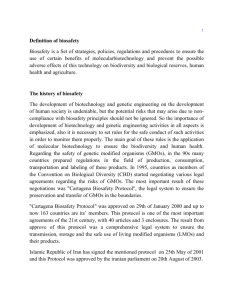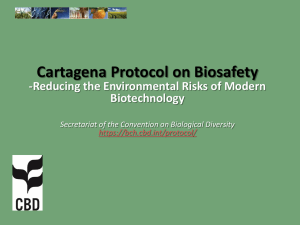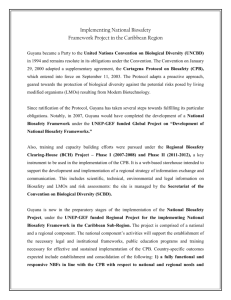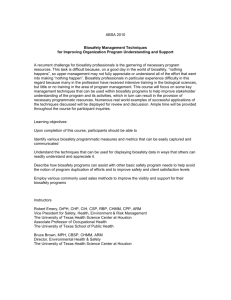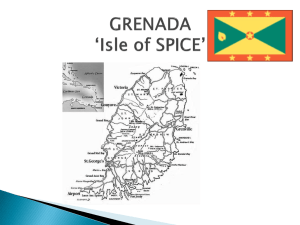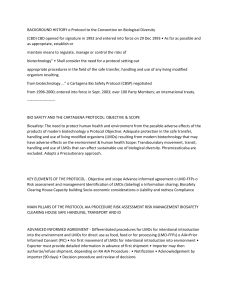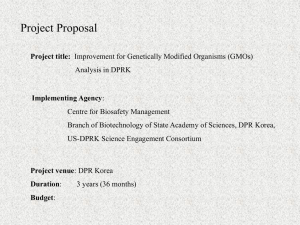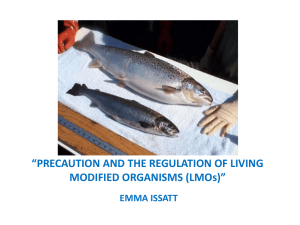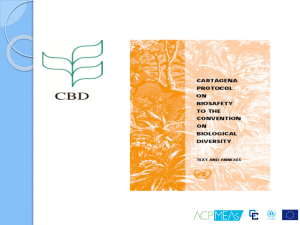Protocol Presentation for Youth - Biosafety Clearing
advertisement
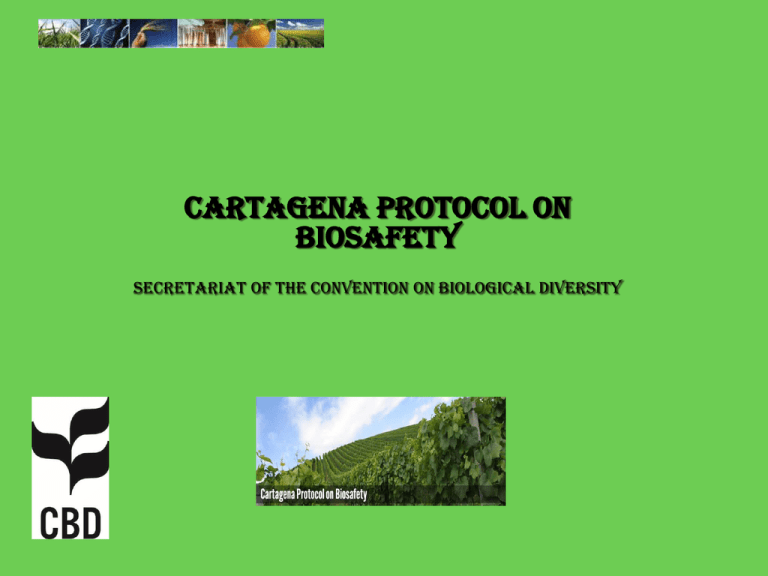
Cartagena Protocol on Biosafety Secretariat of the Convention on Biological Diversity Contents Part 1: What is the Protocol on Biosafety? Part 2: How does the Protocol work? Part 3: What can you do? Part 4: Conclusion II PART 1: What is the Protocol on Biosafety? • An agreement between different countries • Created as an additional agreement to the Convention on Biological Diversity (CBD) • Agreed in January 2000 • Started to have legal Force: September 2003 • 166 countries joined the agreement so far • 6 main meetings of the governing body to date • Next meeting of the Parties: 6 – 10 October 2014; Republic of Korea Goal To promote environmental safety in import-export of living modified organisms (LMOs) that are produced through modern techniques of biotechnology. Biotechnology 10,000 years ago • For example, traditional fermentation techniques used to make bread or cheese or traditional animal and plant breeding techniques. 35 years ago - Modern Biotechnology • Researchers can take a single gene from a plant or animal cell or from a bacteria and insert it in another plant or animal cell in a manner that was not known in traditional breeding. + Promises: Improved agriculture and more food Example: Crops tolerant to water shortages and some diseases - Concerns: Possible loss of biodiversity and harm to human health Example: May result in undesired changes in the existing biodiversity. = Biosafety: Efforts to reduce the possible risks from modern biotechnology and its products. You can have LMOs in the form of: • Seeds or live fish • Grains like corn or canola • Micro-organisms like bacteria used in laboratory or for other purposes PART 2: How does the Protocol work? Objective: Safe Transfer, Handling and Use of LMOs Exporters inform importers and then importers take informed decisions •Assess if the plants or anmials developed domestically or introduced into their territory pose any risk to the environment or health. •Make sure that LMOs shipped from one country to another are safely handled, transported and packaged. •International shipments of LMOs must come with documents that clearly identify the contents of the shipment. •Provide or share with other countries information on and experience with LMOs. Systems to Help Countries: Sharing Information Online in the Biosafety Clearing-House (BCH) Building Capacity in Developing Countries PART 3: What can you do? One Way to Take Action: Celebrate the United Nations Decade on Biodiversity in 2011-2020 Highlight what biosafety has done to protect biodiversity The Protocol has contributed to the 2010 Target as it has prevented loss of biodiversity Learn about biosafety • Visit biosafety website and its Biosafety ClearingHouse (BCH) • Join the RSS on Biosafety • Learn about the LMOs that may be in your country • Learn why biosafety is important Help Take Action to Make Sure there is Biosafety • Inform others • Contact your countries focal points, journalists, nongovernmental organizations and businesses • Discuss with your teachers on the possible development and use educational toolkits on biodiversity and biosafety • Create a factsheet in your language for use by your community • Create a youth biodiversity and biosafety network to exchange information PART 4: Conclusion • Biosafety is an issue for everyone. Every individual, inlcuding youth, has a responsibility and a role to play in making sure that LMOs do not negatively affect biodiversity and human health • • • Living organisms are made up of genetic materials. Scientists have found a way to take genes from some species and insert them into other species to find new varities or breeds of plants or animals. Some people see modern biotechnology as a way to have more food around the world. The new technology can solve the need for food, but it can also cause some problems. These potential problems need to be studied carefully. It is important to make sure that LMOs have no negative effects on biological diversity and human health. The Protocol has requirements that contribute to ensuring safety in the use of biotechnology. It is like a textbook that explains how countries should turn goals into action. Further Information Secretariat of the Convention on Biological Diversity (SCBD) 413 Saint-Jacques Street, suite 800 Montreal, Quebec Canada H2Y 1N9 Tel.: +1 (514) 288-2220 Fax: +1 (514) 288-6588 Visit the Youth Guide to E-mail: Biodiversity -Biosafety and Agriculture section http://www.cbd.int/youth/ secretariat@cbd.int Protocol website: www.cbd.int/biosafety Biosafety Clearing-House: http://bch.cbd.int/
